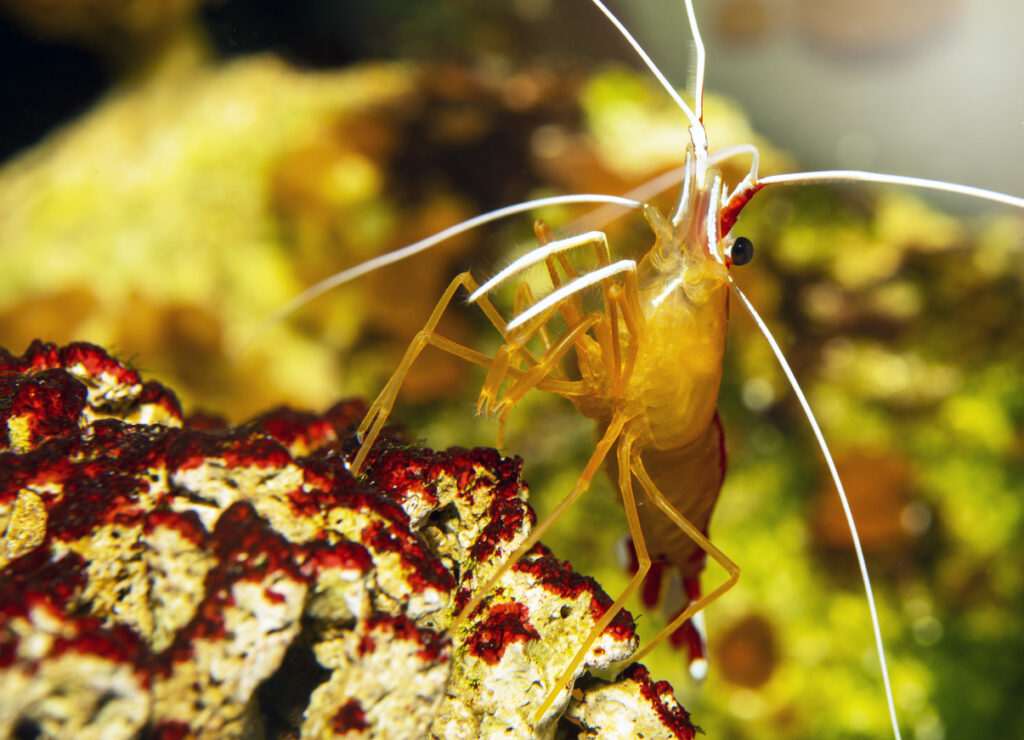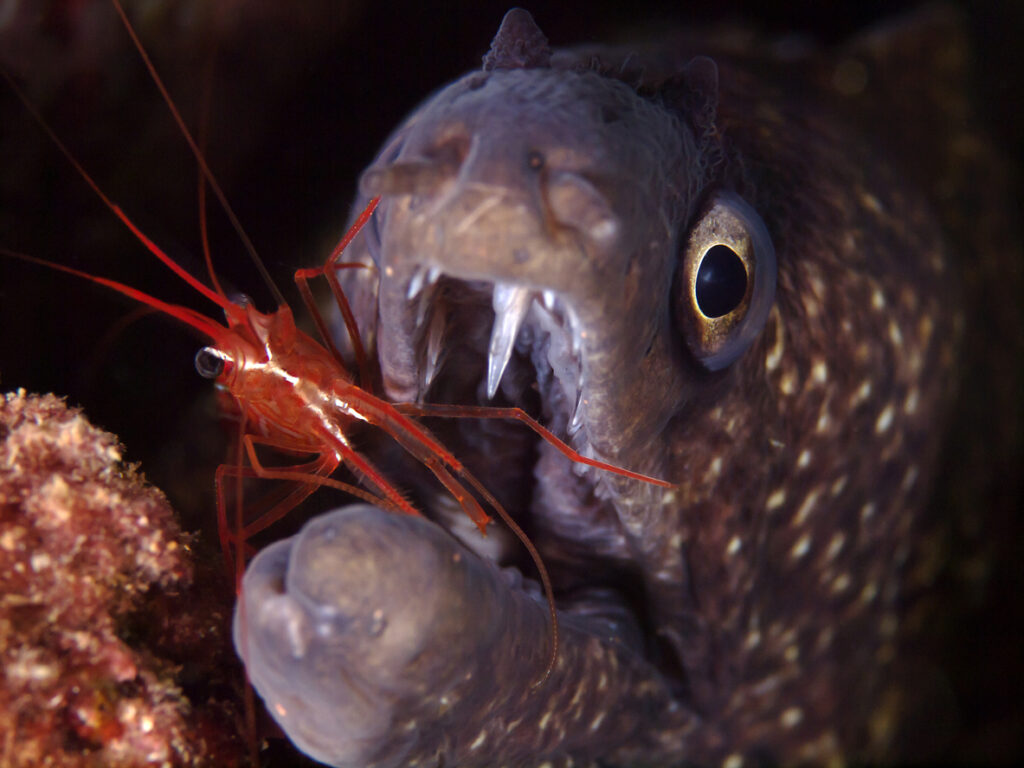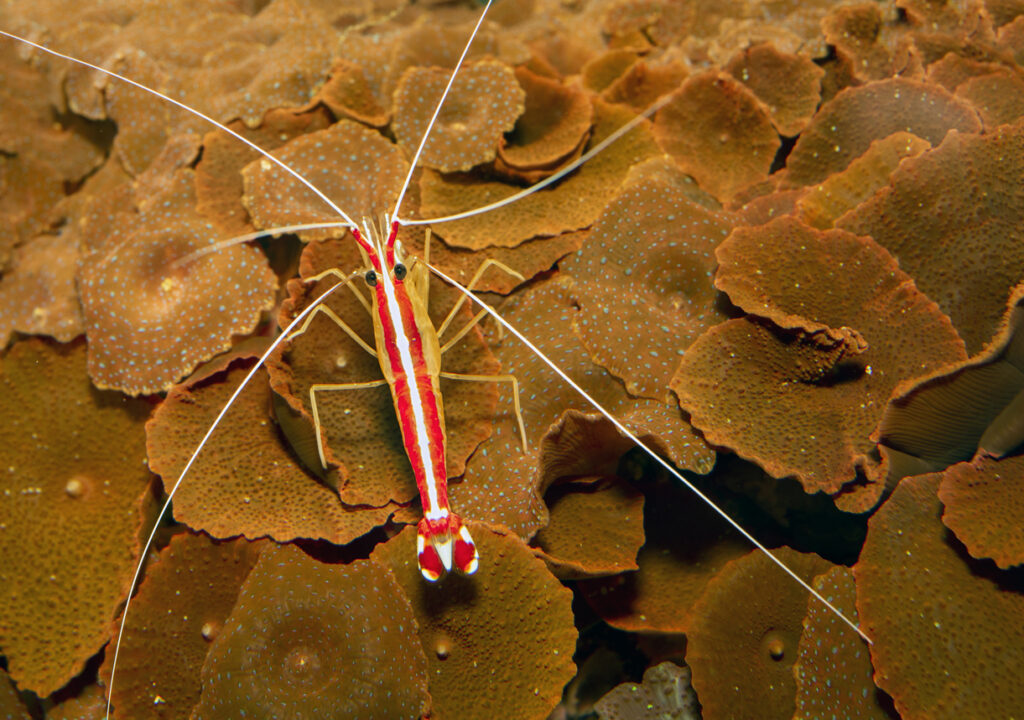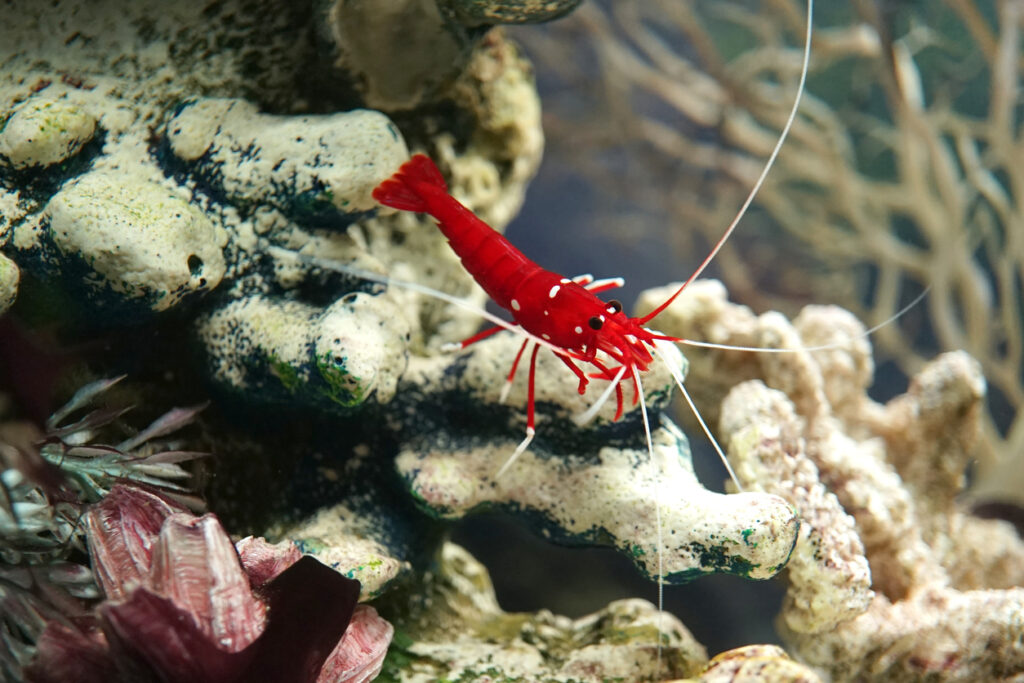Shrimp. You may not think of them as the most exciting animals in our seas and oceans, but they have an important role to play in maintaining the health of marine habitats. This is particularly true of the Pacific cleaner shrimp (Lysmata amboinensis) – one of the busiest and best cleaner-uppers of the deep blue.
So, what makes cleaner shrimp so special? Why are they such a vital part of coral reef ecosystems? And what can you expect from your encounter with these helpful little critters at Tynemouth Aquarium?
Join us as we take an up-close look at the Pacific cleaner shrimp, from its eye-popping appearance to the invaluable work it performs in cleaning up some of the ocean’s most valued marine habitats.

First things first – what do cleaner shrimp look like?
Cleaner shrimp may only be about the size of an adult finger, but you shouldn’t have any difficulty spotting them. That’s because their bodies are a stunning red in colour, with a white stripe running down their backs and an amber-coloured abdomen.
Lysmata amboinensis have no fewer than ten pairs of legs, as well as four long, white antennae that they use for navigation and for detecting food and predators. At first glance, it does look like they have six antennae, but that’s because the one at the centre of their head is split into two.
Along with their distinctive red and white striped bodies, another way to easily identify the cleaner shrimp is by the symmetrical polka dots on their tails. Like many other shrimp species, they also have stalked eyes, though experts believe – after years of testing and experimentation – that the species is colour-blind and may not have the best vision.
Where are Pacific cleaner shrimp found?
No prizes for guessing in which ocean the Pacific cleaner shrimp is most commonly found. Yes, scarlet shrimp (as they’re also known) are found mainly in the Pacific, though they have also been spotted in the Indian Ocean and the Red Sea.
A tropical species, cleaner shrimp live exclusively in coral reef systems, where they perform an invaluable task in keeping the local population healthy (more on this later). They require a warm, saltwater habitat to survive and thrive, which is exactly why they live in our Coral Garden exhibit here at Tynemouth Aquarium.

What do cleaner shrimp eat?
This is where we start to see the cleaning power of the mighty cleaner shrimp.
These small, coral-dwelling critters have a unique diet consisting of parasites, bacteria and dead skin cells. That might not sound all that appetising to us, but for the fish that these shrimp feed off of, it’s literally a matter of life and death.
In order to feed, cleaner shrimp set up something of a “cleaning station” at an opportune spot on the reef; think of it like a car wash for passing fish. Fellow coral-dwellers swim along and allow cleaner shrimp to rid them of any nasties that could affect their health. They even advertise their cleaning services by performing an unusual “dance”, which indicates to passing fish that they’re available for cleaning duties.
Remarkably, it isn’t just the surface of another fish’s skin where cleaner shrimp find food. They’ve also been observed cleaning inside the mouths of other fish, along with species like moray eels.
This might sound like a crafty way for larger fish to score an easy meal, but no, cleaner shrimp are rarely eaten when giving the mouths of bigger species a once-over. It’s all part of a wider symbiotic relationship that these creatures have with other fish on the reef.
As well as munching through bacteria and dirt on other animals, cleaner shrimp also devour similar matter on the surface of coral too. This is an invaluable additional “service” that these small crustaceans offer within reef systems, ensuring that coral is kept clean and free from bacteria and dirt that can inhibit its growth and cause disease.

Cleaner shrimp behaviour and life cycle
Unlike other species of crustaceans, cleaner shrimp don’t generally spend time in large groups. Instead, they’re much more likely to live in pairs, though they are hermaphrodites – meaning they possess both male and female sexual organs.
Typically, a cleaner shrimp will lay up to 300 eggs during a single spawn. These remain attached to the animal in a pleopod before they’re released to “free float” in a plankton-like group.
This floating raft of juvenile cleaner shrimp feeds on other plankton before metamorphosis leads to the development of individual life forms. Baby cleaner shrimp will gradually break away from the group in a process that takes roughly 6-8 weeks.
Once paired up, cleaner shrimp aren’t known to be social creatures and are generally unwilling to interact with other animals of the same species. Indeed, some biologists would call the cleaner shrimp aggressively socially monogamous, with breeding pairs known to kill other crustaceans that try to interfere in their unique daily rituals.

Fun bonus facts about the beloved cleaner shrimp
Have you loved learning about the fascinating cleaner shrimp? Here are a few additional nuggets about these unique coral-dwelling critters…
- The Pacific cleaner shrimp has several names, including the white-banded cleaner shrimp, the scarlet shrimp and the skunk cleaner shrimp.
- It’s thought the feeding habits of cleaner shrimp can help to heal wounds on larger fish, which may go some way towards explaining their symbiotic relationships with other species.
- Cleaner shrimps are becoming increasingly important in the field of aquaculture, where they’re used to help remove parasites and dirt from fish as well as the water itself.
So there you have it, an up-close look at the impressive Pacific cleaner shrimp. These animals may be small but they’re living proof that even the smallest creatures can make a big difference in helping to safeguard the habitats in which they live. Eager to meet them? Book your tickets for Tynemouth Aquarium, where you’ll find a selection of tropical crustaceans over at our Coral Garden.
